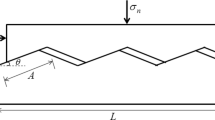Abstract
This study explores the effect of normal stress levels and asperity scales on roughness mobilization characteristics through joint shear tests, and suggests a new method for quantifying rock joint roughness. Two-dimensional joint surface profiles were scanned by using a digital camera-based 3D scanner system, and were classified into a small scale of roughness (unevenness) and a large scale of undulation (waviness). Joint surface profile specimens, duplicated using a wire-cut electric discharge machining method, were tested for shear behaviors. For waviness showing non-stationary signals, the mobilized roughness is not constant but varies nonlinearly at normal stress levels. However, for unevenness showing noise and a stationary signal, the ultimate shear strength appears at a low normal stress level.
Similar content being viewed by others
References
Bandis, S. C., Lumsden, A. C., and Barton, N. R. (1981). “Experimental studies of scale effects on the shear behaviour of rock joints.” Int. J. of Rock Mech. Min. Sci. Geomech. Abstr., Vol. 18, No. 1, pp. 1–21.
Barton, N. R. (1973). “Review of a new shear-strength criterion for rock joints.” Engineering Geology, Vol. 7, No. 4, pp. 287–332.
Barton, N. R. (1976). “The shear strength of rock and rock joints.” Int. J. of Rock Mech. Min. Sci. Geomech. Abstr., Vol. 13, No. 9, pp. 255–279.
Barton, N. R., Bandis, S. C., and Bakhtar, K. (1985). “Strength, deformation and conductivity coupling of rock joints.” Int. J. of Rock Mech. Min. Sci. Geomech. Abstr., Vol. 22, No. 3, pp. 121–140.
Barton, N. R. and Choubey, V. (1977). “The shear strength of rock joints in theory and practice.” Rock Mechanics and Rock Engineering, Vol. 10, No. 1–2, pp. 1–54.
Beer, A. J., Stead, D., and Coggan, J. S. (2002). “Estimation of the Joint Roughness Coefficient (JRC) by visual comparison.” Rock Mechanics and Rock Engineering, Vol. 35, No. 1, pp. 65–74.
Hoek, E. and Bray, J. W. (1981). Rock slope engineering, Revised Third Edition, The Institute of Mining and Metallurgy, London.
Hong, E. S. (2005). Characterization of rock joint roughness based on roughness mobilization characteristics, PhD Thesis, Dept. of Civil and Environmental Engineering, Korea Univ., Seoul, Korea.
Hong, E. S., Lee, I. M., and Lee, J. S. (2006a). “Measurement of rock joint roughness by 3D scanner.” Geotechnical Testing Journal, Vol. 29, No. 6, pp. 482–489.
Hong, E. S., Lee, J. S., and Lee, I. M. (2008). “Underestimation of the roughness in rough rock joint.” International Journal for Numerical and Analytical methods in Geomechanics, Vol. 32, No. 11, pp. 1385–1403.
Hong, E. S., Lee, J. S., Shin, H. S., Choi, S. O., and Lee, I. M. (2006(b)). “Characteristics of roughness mobilization.” ISRM International Symposium 2006 4th Asian Rock Mechanics Symposium — Rock Mechanics in Underground Construction, Singapore, p. 314.
Hsiung, S. M., Ghosh, A., Ahola, M. P., and Chowdhury, A. H. (1993). “Assessment of conventional methodologies for joint roughness coefficient determination.” Int. J. of Rock Mech. Min. Sci. Geomech. Abstr., Vol. 30, No. 7, pp. 825–829.
Huang, T. H. and Doong, Y. S. (1990). “Anisotropic shear strength of rock joints.” Proceedings of the International Symposium on Rock Joints, Leon, Norway, pp. 211–218.
ISRM (International Society for Rock Mechanics) (1981). Rock characterization testing and monitoring, ISRM suggested methods, Edited by E.T. Brown, Pergamon Press, Oxford.
Krahn, J. and Morgenstern, N. R. (1979). “The ultimate frictional resistance of rock discontinuities.” Int. J. of Rock Mech. Min. Sci. Geomech. Abstr., Vol. 16, No. 2, pp. 127–133.
Kulatilake, P. H. S. W., Shou, G., and Huang, T. H. (1995). “Spectralbased peak-shear-strength criterion for rock joints.” Journal of Geotechnical Engineering, Vol. 121, No. 11, pp. 789–796.
Lopez, P., Riss, J., and Archambault, G. (2003). “An experimental method to link morphological properties of rock fracture surfaces to their mechanical properties.” Int. J. of Rock Mech. Min. Sci., Vol. 40, No. 6, pp. 947–954.
Maksimoviæ, M. (1996). “The shear strength components of a rough joint rock.” Int. J. of Rock Mech. Min. Sci. Geomech. Abstr., Vol. 33, No. 8, pp. 769–783.
Poon, C. Y. and Sayles, R. S. (1992). “The classification of rough surface contacts in relation to tribology.” J. Phys. D: Appl. Phys., Vol. 25, No. 1A, pp. A249–A256.
Seidel, J. P. and Haberfield, C. M. (1995). “The application of energy to the determination of the sliding resistance of rock joints.” Rock Mechanics and Rock Engineering, Vol. 24, No. 4, pp. 211–226.
Suh, N. P. and Sin, H. C. (1981). “The genesis of friction.” Wear, Vol. 69, No. 1, pp. 91–114.
Author information
Authors and Affiliations
Corresponding author
Rights and permissions
About this article
Cite this article
Hong, ES., Lee, IM., Cho, GC. et al. New approach to quantifying rock joint roughness based on roughness mobilization characteristics. KSCE J Civ Eng 18, 984–991 (2014). https://doi.org/10.1007/s12205-014-0333-5
Received:
Accepted:
Published:
Issue Date:
DOI: https://doi.org/10.1007/s12205-014-0333-5




